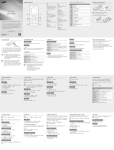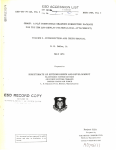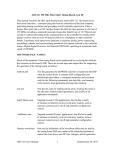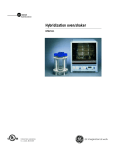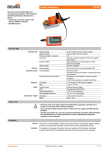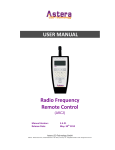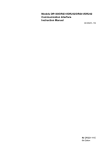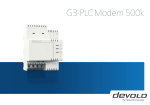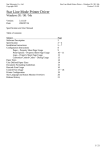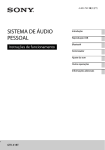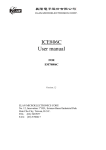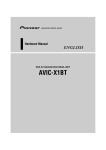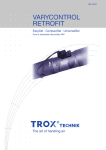Download Users` Manual
Transcript
ARC-48: 8-Channel CCD Video Processing Board This manual describes the 8-channel CCD video processor board, model ARC-48 Rev. 1A. The board serves two functions - processing and digitizing the video outputs from one to eight CCD video channels and supplying DC bias voltages to the CCD(s). It contains eight identical video processing circuits that can simultaneously process and digitize signals from eight CCD video outputs. Eight 18bit analog-to-digital (A/D) converters are provided on the board, along with a 16-bit data pathway to the backplane. Their outputs are multiplexed on the backplane on dedicated A/D data pins from which they are transmitted by the timing board to the host computer. The DC bias supply section of the board provides 32 separate low noise, digitally programmable voltages with a variety of voltage ranges suitable for direct connection to CCDs, and a video offset voltage for each of the eight video processors. VIDEO PROCESSING The CCD output source signal, sometimes called CCD video, can be connected directly to the input of the board to a single-ended FET input stage that also has provision for the user to install a source load resistor for each CCD output circuit. These load resistors (R203 in channel #0) are mounted on fork terminals to enable the user to install and replace them without damaging the board. The load resistors are normally NOT installed at the factory. A 0.1 μf capacitor AC couples the CCD video to the FET amplifier, which is a low noise 2N5564. This preamp plus the following amplifier stage operates at a gain of x2.8. There is also differential input to the board that is suitable for receiving outputs from preamps located near the CCD and some meters away from the controller, operating at unity gain. Selection of operation in single or differential input mode is made by wiring the input signals to the appropriate pins on the input DB67 connector and by setting the switches SW1 to SW8. The figure shows the two possibilities. The input connector is a triple row, 62-pin DB male connector, Positronic part #ODD62M400T0. We generally supply the matching female connector #ODD62F21000. The pinout for the connector is shown at the end of this user’s manual, along with a schematic representation of the connector. Vin_H:0-7, are the high impedance signal inputs that go to the single ended input FET stages and the load resistors. The pins named Vin_L-# can be used as reference grounds, and are connected to the analog ground plane through the switches described above. The differential input stage, generally driven by a low impedance differential output preamplifier, is accessed through the pins Vin_L-# and Vin_L+#, which form a balanced input to the differential amplifier. Two resistors connect the low impedance input pins to the differential amplifier, the THS4131, of the low impedance, differential input stage. We found them to induce significant noise into the high impedance signal path, so have not populated them. If users desire to use the low impedance, ARC-48 User's Manual 1 Updated September 27, 2007 differential input stage they need to install 0805 SMT resistors in the locations R214 and R213 shown in the figure of the back of the board. For balanced inputs such as would be supplied by a differential preamp located next to the CCD these two resistors should have equal values, and the gain of the stage is just the value of the feedback resistor divided by this input resistor. The nominal values for R213 and R214 are 316 ohms, with the feedback resistors having a value of 630 ohms for a gain of x2. It is also possible to connect unbalanced low impedance outputs to the differential input stage such as might occur with simple source follower FET preamps. The low impedance negative side should be grounded, and the resistor R213 on the positive side should be chosen so that the sum of the output impedance preamp and the resistor R213 is about the same as the other resistor R214. This way the differential amplifier will remain balanced. The various video input pinouts are as follows: Vin_H0 = pin 43 Vin_L-0 = pin 1 Vin_H1 = pin 44 Vin_L-1 = pin 2 Vin_H2 = pin 45 Vin_L-2 = pin 3 Vin_H3 = pin 46 Vin_L-3 = pin 4 Vin_H4 = pin 59 Vin_L-4 = pin 39 Vin_H5 = pin 60 Vin_L-5 = pin 40 Vin_H6 = pin 61 Vin_L-6 = pin 41 Vin_H7 = pin 62 Vin_L-7 = pin 42 The differential input stage, generally driven by a low impedance differential output preamplifier, is accessed through the pins Vin_L-# and Vin_L+#, which form a balanced input to the differential amplifier. Vin_L+0 = pin 22 Vin_L-0 = pin 1 Vin_L+1 = pin 23 Vin_L-1 = pin 2 Vin_L+2 = pin 24 Vin_L-2 = pin 3 Vin_L+3 = pin 25 Vin_L-3 = pin 4 Vin_L+4 Vin_L-4 Vin_L+5 Vin_L-5 Vin_L+6 Vin_L-6 Vin_L+7 Vin_L-7 pin 17 pin 39 pin 18 pin 40 pin 19 pin 41 pin 20 pin 42 This amplifier following the FET input stage has a differential output that is connected to an analog switch that selects either inverted or non-inverted output for accomplishing the correlated double sampling. The next stage is a programmable gain stage that has fifteen gain selections that are software selectable according to the table below. ARC-48 User's Manual 2 Updated September 27, 2007 code gain 0 5.625 1 5.250 2 4.875 3 4.500 4 4.125 5 3.750 6 3.375 7 3.000 code gain 8 2.625 9 2.250 10 1.875 11 1.500 12 1.125 13 0.750 14 0.375 15 forbidden The next stage is the integrator, which has a time constant of 0.5 microsec, determined by R = 499 ohms and C = 1 nf. An integration time of 0.5 microsec will produce unity gain from this stage. The integration analog switch is closed to enable the integrator, and the reset integrator switch is closed to discharge the integration capacitor after each pixel is sampled. The following stages convert the single ended output of the integrator to differential signals required by the Analog Devices AD7641 A/D converter. It is a fast 18-bit part that samples its input during the time before its start A/D signal goes high to initiate the conversion. The digital output data from each of the eight A/D converters are written to a single FIFO, and then transmitted to the backplane through one of two latches. One latch maps the most significant of the 18 A/D bits to the 16 backplane lines for transmission by the timing board to the computer, whereas the other latch maps the least significant 16 bits. Selection of which of these modes is operational is made in software as described below. These fast timing signals, known collectively as SS# for Switch State, are generated by the timing board, and latched by the WRSS (WRite Switch State) control signal. The software on the timing board executes the “CLOCK” routine to read the switch state bits from waveform tables and write them to the backplane along with the WRSS control signal. If the bits SS:15-12 match the jumper setting JP9, JP7, JP5 and JP3 on the rising edge of WRSS then the bits SS6-SS0 will be latched onto the video board. The bit assignment and functionality is similar to that used on the dual channel ARC45 video processor, except that the two polarity bits POL+ and POL- have been replaced by just one, and the DC Restore function has been eliminated, as follows: Function Schematic name Timing Reset integrator Polarity Integrate Start A/D C_RST INV_SIG INTG CNST SS0 SS3 SS4 SS5 Transfer A/D XFER SS6 ARC-48 User's Manual Description Low to reset the integrator Low to invert Low to integrate Low to high transition to start A/D conversion Low to high transition to transfer data from A/Ds to FIFO 3 Updated September 27, 2007 The jumper header for the switch state addressing is located in the upper right hand corner of the board next to the large surface mount PAL. The figure to the right shows what the jumper headers look like, with jumpers installed to select a logical “1” in the SS:15-12 bit field. The DAC and A/D select jumper headers are also shown and will be discussed below. Generally the video board address is set to zero in the software provided, so no jumpers should be installed in the SWITCH field. The gain is determined by the signals GAIN:3-0 routed identically to all eight video processors. The gain value is set in software by writing a 25-bit serial word over the synchronous serial interface pins TIM-A-SCK and TIM-A-STD, generally with the XMIT_A_WORD in the ARC-22 timing board firmware. The command is sent to all video boards in the system. The argument for the XMIT_A_WORD command is as follows: bits 23-20 = not used bits 19-16 = %D, to select the video gain function bits 15-4 = not used bits 3-0 = gain code listed above The DSP software to set the gain at x4.5 would be: MOVE JSR #$0D0003,A <XMIT_A_WORD Similarly, the mode for transmitting either the lowest or highest 16- bits of the A/D 18 bit output is done with the same sort of command, along with some other options to be discussed below: bits 23-20 = not used bits 19-16 = $C, to select the video board options bits 15-4 = not used bit 0 = 1 for WARP mode on; = 0 for WARP mode off (default) bit 1 = 1 for least significant 16 bits; = 0 to select the most significant (default) bit 2 = 1 to enable the DAC outputs (default); = 0 to disable them bit 3 = 1 to clear the image data FIFO The DSP software to select the least significant 16 bits would be: MOVE JSR #$0C0002,A <XMIT_A_WORD All three bits #2-0 are written to latches on the board whenever the $C address is selected. If bit #3 is set to a one a short reset pulse will be issued to the FIFOs on the board, and the three bits #2-0 will also be written to the latches. DC BIAS SUPPLIES AND VIDEO OFFSETS ARC-48 User's Manual 4 Updated September 27, 2007 The DC bias voltages and video offsets are all generated by a single 40-channel digital-to-analog converter (DAC), the Analog Devices part AD5379. It is programmed over the same synchronous serial interface described above that sets the video gain. There are four DC bias supplies and one video offset voltage supply allocated for driving each of the 8 channels of the CCD. The table of available voltages follows, where names are assigned to suggest how a typical CCD is operated. The Vrsv is named for “reserved” and is available for general use. Vod0 = pin 52 Vod1 = pin 32 Vod2 = pin 11 Vod3 = pin 53 Vod4 = pin 33 Vod5 = pin 12 Vod6 = pin 54 Vod7 = pin 34 Vrd0 pin 25 Vrd1 = pin 13 Vrd2 = pin 35 Vrd3 = pin 14 Vrd4 = pin 56 Vrd5 = pin 36 Vrd6 = pin 15 Vrd7 = pin 57 Vog0 = pin 29 Vog1 = pin 8 Vog2 = pin 50 Vog3 = pin 30 Vog4 = pin 9 Vog5 = pin 51 Vog6 = pin 31 Vog7 = pin 10 Vrsv0 = pin 5 Vrsv1 = pin 47 Vrsv2 = pin 27 Vrsv3 = pin 6 Vrsv4 = pin 48 Vrsv5 = pin 28 Vrsv6 = pin 7 Vrsv7 = pin 49 The approximate voltage range for each category is: Vod = 0 to 30 volts Vrd = 0 to 20 volts Vog = Vrsv = -9 to +9 volts The AD5379 DAC is a relatively complex part with 14-bit voltage resolution. It contains internal registers that program the voltage as well as a gain and offset for each channel. Rather than fully explain how the programming is done the user is referred to the part’s data sheet and the waveforms file supplied with the board. The board address is encoded in each word written to the DAC in bits D23-20, which must match the jumpers placed in the “DAC A/D” area described above, with a jumper installed signifying a “1”. The output of the DAC can be turned on and off in software. This is done on power-up in the “timCCDmisc.asm” routine. Bit 2 of the board options word does this selection, so the command would be: MOVE JSR #$0C0004,A <XMIT_A_WORD ; To turn on IMAGE DATA TRANSFER The four jumpers marked "DAC A/D" set the address that the board will respond to when writing to the DC bias DAC or reading image data. These must be set to different values for each video board in a system so each board can be uniquely addressed, whereas the “SWITCH” jumpers are usually set to the same value for all video boards in the system so they all operate with the same timing. There are two modes for transferring image data from the A/Ds to the image data FIFO. In the “eight-channelsall-at-once” mode (TIM_V_AUX1 = 0) all eight A/D values on each board are transferred in turn to the image data FIFO on the rising edge of XFER. They will be transmitted over the backplane ARC-48 User's Manual 5 Updated September 27, 2007 whenever the bits TIM-ADAD:6-3 match the jumpers "DAC A/D" on each video board starting with A/D#0 and ending with A/D#7, ignoring the bits TIM-A-ADAD:2-0. In the 'one A/D at a time mode' (TIM_V_AUX1 = 1) the addresses TIM_ADAD:2-0 select which of the eight A/Ds on the board gets its data written to the FIFO, after which it is written directly to the backplane and transmitted to the host computer. The default software supplied with the system has the “one-at-a-time” mode selected. The image data FIFO can be cleared by setting bit 3 of the board options word: MOVE JSR #$0C0008,A <XMIT_A_WORD ; Clear image data FIFO The AD converter has a special mode called WARP that allows it to run at a higher speed than the normal mode, but with a restriction on the length of time allowed between conversions. To enable this mode the WARP bit in the board options word is set: MOVE JSR #$0C0001,A <XMIT_A_WORD ; enable WARP mode Note that all four options bits are written whenever the “C” address is selected, so care must be taken when changing one mode not to change the other ones inadvertently. ARC-48 User's Manual 6 Updated September 27, 2007






